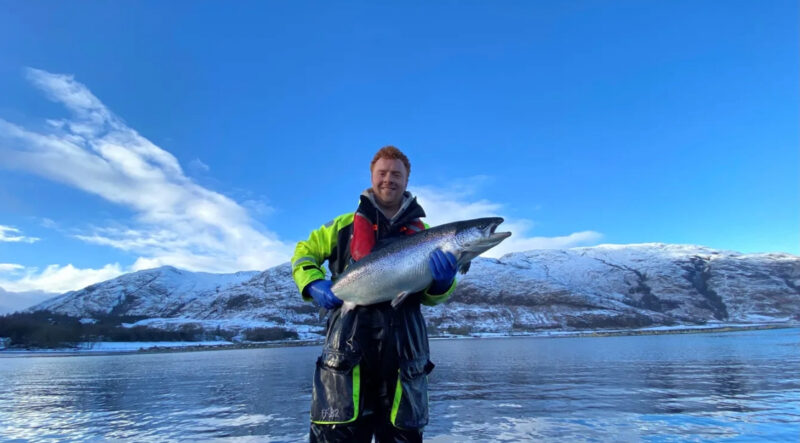Another study shows salmon farms pose low disease risk to wild fish
No apparent relationship between the prevalence of virus infection in wild salmon and fish farms states a new Norwegian study, reaffirming conclusions of Canadian and U.S. scientists.
By Fabian Dawson
SeaWestNews
A new study in Norway has found that there is little viral and bacterial transmission from farmed fish to wild fish, reaffirming the conclusions of Canadian and U.S. government scientists who researched the impacts of salmon farming in the Pacific Northwest.
The study by Norway’s Institute of Marine Research, conducted in farming-intensive areas, is part of an annual monitoring program by the Norwegian Food Safety Authority, reported Fishfarmingexpert.com.
The current findings are in line with previous monitoring reports in Norway that showed no apparent relationship between the prevalence of virus infection in wild salmon and the fish farms.
“The results of the monitoring programme indicate that there is a very low incidence of infection in migrating wild salmon and sea trout…It also seems that there is low infection from farmed fish to wild fish,” said study researcher Abdullah S. Madhun.
“It appears that the prevalence of infections in wild fish, caused by the examined viruses and bacteria, is not significantly influenced by the occurrence of these infections in fish farming.
“The results may also indicate that it is unlikely that wild fish act as a reservoir for the investigated viruses and bacteria,” said Madhun, according to Fishfarmingexpert.com.
The investigations were carried out on 50 salmon post smolts caught in the Boknafjorden, 50 from the Hardangerfjord, and 38 sea trout captured outside Hitra.
“These are farming-intensive areas where the farmed fish have different disease profiles. If wild fish are affected by the farmed fish in terms of infection, then we expect to find such infection in wild fish caught in these areas,” said Madhun.
The Norwegian study mirrors findings by the Canadian Science Advisory Secretariat (CSAS), which coordinates the scientific peer review and science advice for the Department of Fisheries and Oceans.
CSAS has produced nine scientific studies to show that the salmon farms in British Columbia pose less than a minimal risk to wild stocks.
A recent sweeping American study about open-net aquaculture in the Pacific Northwest has also shown that the claims being made by anti-salmon farm activists in Washington State and neighbouring British Columbia to be false.
The 215-page biological opinion by the Marine Service of the National Oceanic and Atmospheric Association (NOAA) found that marine finfish aquaculture in Puget Sound, has little to no negative impact on native species, such as endangered salmon, Orcas, or their habitats.
Courts in Canada and the United States, relying on expert testimony, have also ruled that claims about disease and sea lice impacting wild stocks, widely propagated by anti-fish farm activists in the Pacific Northwest, to be without merit.
Last week, British Columbia’s salmon farmers and their First Nation partners released a comprehensive review of their aquaculture operations called Modern Salmon Farming in British Columbia: A Review, aimed at closing the knowledge gaps about the industry and counter the campaign of disinformation by anti-salmon farming opponents.
The 500-page collaborative report, which was commissioned by the Coalition of First Nations for Finfish Stewardship, lists hundreds of scientific studies that show salmon farms in BC have less than a minimal impact on wild stocks.
Topics covered in the publication across 13 chapters include the current state of Pacific salmon, sea lice, fish health, benthic conditions, incidental catch, mammal interactions, and First Nations stewardship.
Members of the Coalition and representatives of the salmon farming sector are in Ottawa this week to share the “scientific textbook” with politicians and government officials.
Their visit comes at a critical juncture for the aquaculture industry in BC as the Federal government considers renewing salmon farming licences which expire this Spring pending the formulation of a Transition Plan for the sector in the province.
The Liberal government, at the behest of activists, has already shut down 40% of salmon farms in BC since 2020, increasing carbon emissions and wiping out jobs that are the lifeblood of rural, coastal and Indigenous communities.
Before the shutdowns the salmon farming sector was the largest agri-food export in BC. The sector employed approximately 6,500 people, produced close to 500 million salmon meals per year, received inputs from over 1,000 individual suppliers and had an economic value of $2 billion.
Currently in BC, all existing salmon farms are supported by the First Nations communities that they operate in.
(Image courtesy of Mowi)

